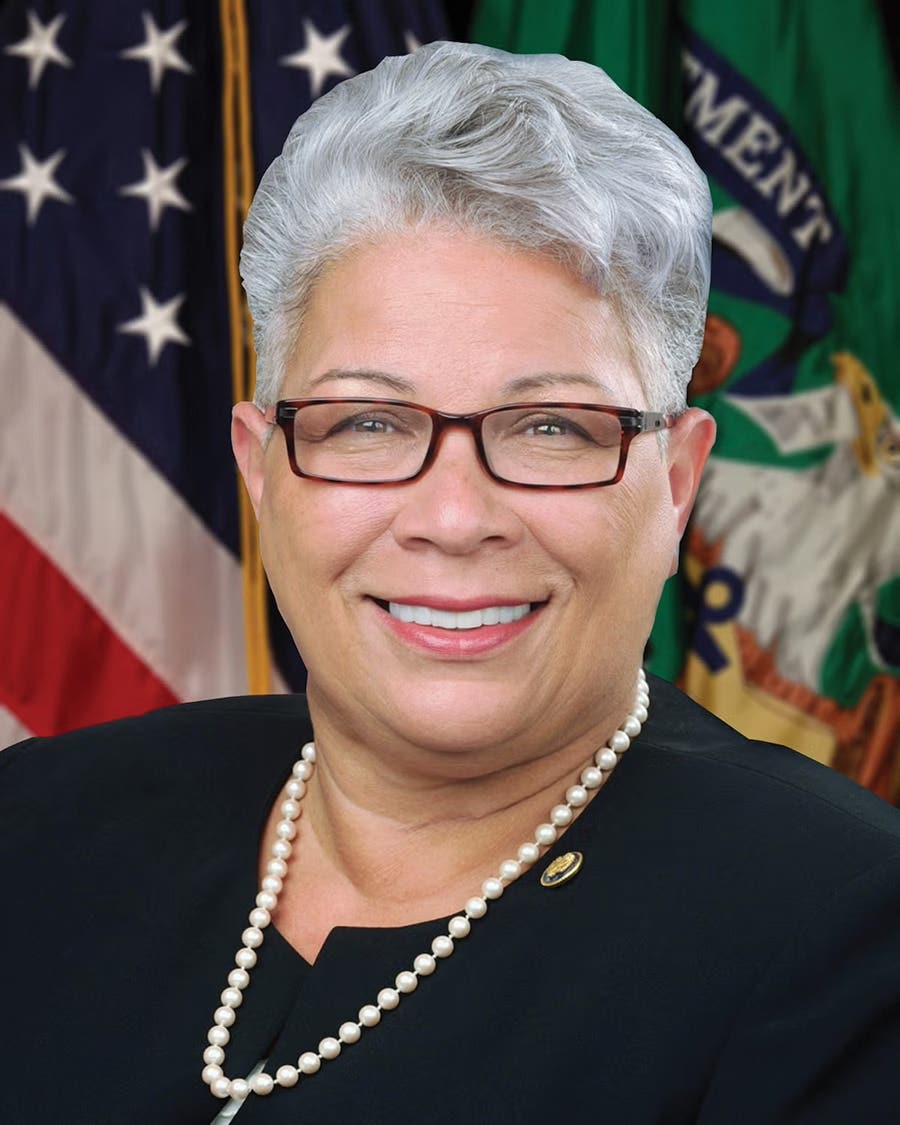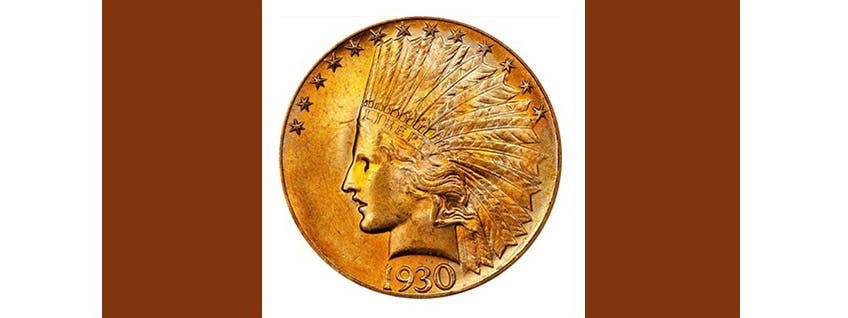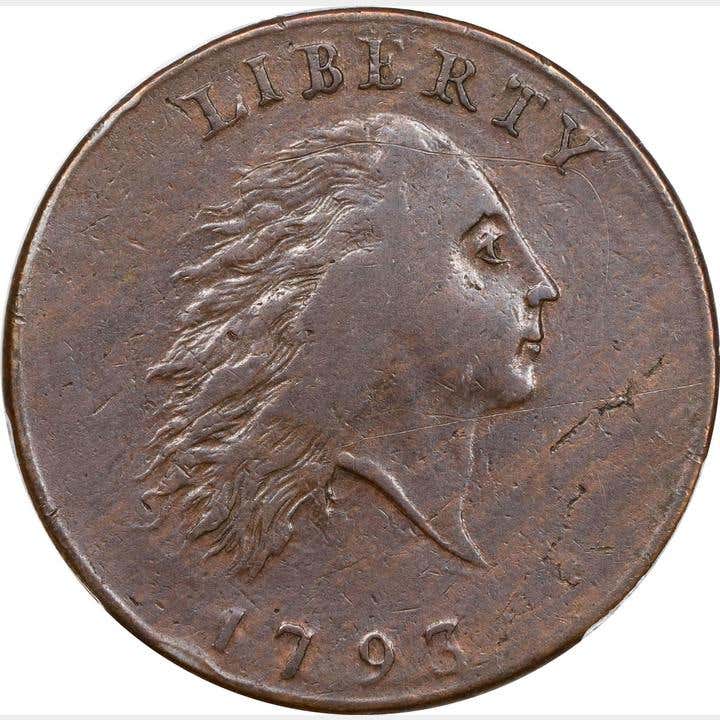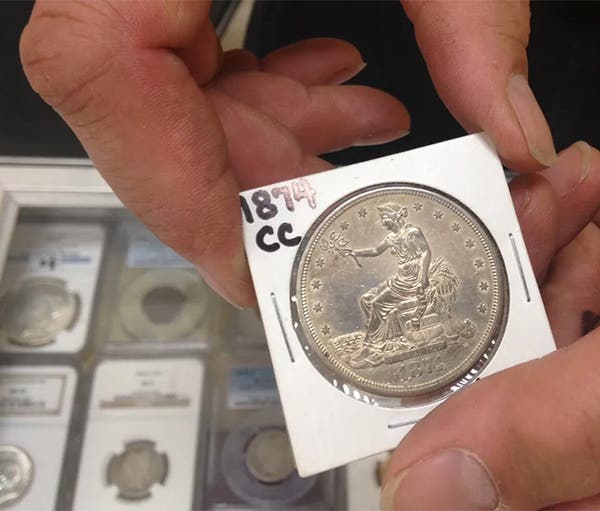Collecting American Eagle Platinum Coins
Have you given any thought to collecting platinum bullion coins? Is there a rationale for collecting American Eagles minted on platinum planchets? And how does platinum compare to gold as…
Have you given any thought to collecting platinum bullion coins? Is there a rationale for collecting American Eagles minted on platinum planchets? And how does platinum compare to gold as an investment?
As I write this, gold’s value is $1,922 an ounce, with platinum at $951 an ounce. In other words, gold is worth more than twice as much as platinum. This gold/platinum differential hasn’t always been the case, however.
A graph comparing platinum and gold values over time reveals that for many years platinum’s value was significantly above that of gold. This was true from about 1946 through the mid 1970s, at which time gold dramatically increased to make the two metals approximately equal in value. They stayed this way until the turn of the century. At that point, platinum again gained the edge and held it until about 2005, when the two metals began to track each other in a gradual decline for the next decade. After that, platinum continued the decline whereas gold rose in value to give us the situation today.
If rarity were the sole factor determining value, the much rarer platinum would be worth considerably more than gold. As just one measure of this relative rarity, approximately 2,500 to 3,000 tons of gold are extracted annually compared to fewer than 200 tons of platinum.
The bulk of the world’s platinum comes from Russia and South Africa. By contrast, the countries contributing significantly to the world’s gold production are China, the United States, Australia, and Canada, in addition to Russia and South Africa.
Both precious metals have a variety of uses, including coins and jewelry. Platinum is also used in laboratory equipment, dentistry equipment, and automobile catalytic converters. This last usage, to convert “. . . toxic gases and pollutants in exhaust gas from an internal combustion engine into less-toxic pollutants. . .,” makes catalytic converters theft targets for their platinum. My daughter, who parks on the street in Chicago, tells me that the catalytic converter in her Prius has been stolen twice.
If you think that platinum in coin form might be a good investment because of its rarity, multiple uses, and its value history relative to gold, then platinum American Eagles may be interesting coins to collect.
Note that I said “collect” rather than “invest.” I agree with David Bowers, who has long maintained that you should be a collector first, not an investor. As a collector, you’ll be more likely to educate yourself on the items you purchase. In addition, you’ll have the enjoyment of putting together your collection, the well-earned pride in your set of platinum coins. With this in mind, let’s look at American-made platinum coins.
The American Platinum Eagle program took flight in 1997 through the efforts of ANA President David L. Ganz, United States Mint Director Philip N. Diehl, and Jacques Luben, Executive Director of Platinum Guild International. The American Platinum Eagle became the official platinum bullion coin of the United States.
Four different coin sizes/denominations were minted at the outset of the program: 1/10 ounce, $10 face value; 1/4 ounce, $25; 1/2 ounce, $50; and 1 ounce, $100. Although the coins are legal tender, it would be both difficult and foolish to spend one. The three lower denominations were minted through 2008, with only the 1-ounce coins continuing after that.
The American Eagle platinum coins were minted in two versions, uncirculated and proof, with the uncirculated coins made in Philadelphia, the proofs at the West Point Mint (W). The uncirculated coins carry the same designs throughout, with an obverse featuring the head of the Statue of Liberty and a reverse showing an eagle in flight. These designs were the handiwork of John M. Mercanti (obverse) and Thomas D. Rogers Sr. (reverse).
Made for collectors, the proof coins had the unvarying Mercanti and Rogers’ designs in the first year (1997) and the twentieth year (2017), with changing reverses in all other years. I’ll say more about the reverse designs when I discuss the $100 platinum eagles.
Proofs are sold directly to the public, whereas the uncirculated coins are sold only to the Mint’s authorized buyers. The Mint’s web site (usmint.gov) has a list of ten authorized purchasers. Interestingly, all but one of the ten buy all four of the Mint’s bullion coins (gold, silver, platinum, palladium). The odd dealer, The Gold Center, buys only silver bullion coins!
Unlike the modern commemoratives, the uncirculated $10 platinum eagles tended to have larger mintages than their proof counterparts, with the highest mintages of both versions occurring in the first year of production. This is what we often see with newly introduced coin series. Here, however, it only occurred with the $10 denomination, perhaps because more collectors chose to dip a toe into the platinum bullion waters at the lowest cost option.
Mintages appear low throughout the $10 series, particularly if you’re comparing them with regularly issued coins. The lowest mintages in the $10 series are held by coins struck on specially burnished planchets in the last three years (2006-2008). These planchets produce coins with a satin-like finish. Struck at West Point along with proofs, they were sold directly to the public. Unlike the uncirculated $10 coins, the reverse design of coins on burnished planchets was the same as the proofs minted the same year. Mintages for the three years were 3,544 (2006), 5,556 (2007), and 3,706 (2008).
Values for the $10 platinum eagles show little variability in some major pricing guides, perhaps because they are given for a single, unspecified grade. For example, in the 2022 Red Book (A Guide Book of United States Coins), the only designations are Unc. (Uncirculated) and PF (Proof).
In Market Watch (MW), the values are $174 for the uncirculated coins, $204 for the proof versions. The only uptick in value occurs for the burnished uncirculated eagles, which are listed at $300 (2006), $180 (2007), and $250 (2008).
According to the PCGS value guide, which lists all grades between 60 and 70, with a few exceptions, major value changes occur only with the highest grades of -69 or -70. For example, the 1997 MS69 $10 Eagle is valued at $235, which is about $70 more that its value in all lower grades. In MS70, the value leaps to $2,100.
PCGS values for the PR70 DCAM (deep cameo) $10 issues range from a low of $285 (2000-W and 2006-W) to a high of $550 (2008-W). On eBay, sellers offered PR70 DCAM $10 platinum eagles priced between $299.99 for dates such as the 2000-W to a high of $2,300 for a First Strike 2008-W. Without the First Strike designation, I found a 2008-W selling for $577.50.
The MW values for the burnished issues are roughly half of those in the PCGS guide, which are $550 (2006), $350 (2007), and $525 (2008). Even these higher values are less than eBay sellers are asking for their coins.
I found all three of the burnished dates listed on eBay. For the 2006-W, the seller’s price was $969. Three 2007-Ws ranged in price from $666-$750, and a 2008-W was offered at $709. None of the sellers advertised that they would entertain offers.
The biggest jump in value from MS69 to MS70 is for the 1998, as its PCGS value goes from $260 in MS69 to a whopping $12,350 in MS70! Could you tell the difference between one in -69 and one in -70? I don’t think I could.
On eBay, I found only one MS70 1998 certified by one of the major certification services, NGC. Although listed at $15,600, the seller would entertain offers. There were several MS70 1998s in ICG (Independent Coin Graders) holders priced considerably below the PCGS MS70 value. I suspect that neither PCGS nor NGC would consider ICG coins the equal of their MS70s.
On eBay, the prices listed for the different dates seemed mostly reasonable relative to PCGS values. Of course, there were some sellers who were offering overpriced items, but if you know the market values, (see pcgs.com/prices or ngccoin.com/price-guide) you should be able to purchase nice coins for the right price. There were several ungraded coins for sale, but you should ignore these when there are so many PCGS and NGC-certified coins available.
$25 Quarter-Ounce Platinum Eagles
MW has these valued at $325 for the uncirculated version and $355 for the proofs. Again, the ones struck on burnished planchets have higher values than either the ones in mint state or in proof: $475 (2006-W), $550 (2007-W), and $425 (2008-W).
Once again, the PCGS values are considerably higher than those in MW. The most expensive MS70 $25 platinum eagles are 1997 ($4,500), 1998 ($1,350), 1999 ($5,000), 2000 ($4,250), and 2001 ($4,000). The remainder are valued between $600 and $750.
PCGS values for the PR70s range from $460 for a 2002-W to $810 for a 2004-W. Values for the three burnished quarter eagles in MS70 are $925 (2006), $850 (2007), and $1,500 (2008).
On eBay, I found 238 examples certified by either NGC or PCGS. The least expensive were MS69 coins, which you could purchase for $395 with free shipping. As you can see, these are priced well above the MW values. The least expensive MS70 was a $425 2008, with free shipping. It seemed like such a bargain that I ordered it!
Of the five quarter eagles with hefty values in MS70, there were only two examples on eBay, both dated 1997. One was $3,336 with free shipping, the other $4,500 with $39.95 shipping. Which would you buy?
All four of the burnished quarter eagles listed on eBay were 2006-Ws, and the range of asking prices was from $1,295 to $1,700, all much higher than the PCGS value for the date. In the case of the proof quarter eagles, the range of prices on eBay was from $475 for a 1998-W in PR70 DCAM to $2,599.99 for another 1998-W in the same grade. The latter seller was offering a discount of $10 with the appropriate coupon.
$50 Half-Ounce Platinum Eagles
MW has the half-ounce platinum eagles valued, with a few exceptions, at $626 for the uncirculated version and $656 for the proofs. The exceptions are the 2004-W ($1,230) and the burnished uncirculated issues, which have slightly different values. I suspect that the $1,230 value is a typo, as other guides attach no particular significance to this issue.
Worth noting here and also for the $25 and $100 issues is a variety known as the “Frosted Freedom” proof. This is a 2007-W issue with a reverse design that includes the word “FREEDOM,” which has received a special treatment. Instead of values for this issue, MW just has the word “rare” for both the $25 and $50 platinum eagles. The value for the $100 version is $47,000!
Mintages for the three 2007 Frosted Freedom issues are 21 for both the quarter eagle and half eagle, and 12 for the eagle. The PCGS Pricing Guide indicates that only one of the $25 Frosted Freedom coins is known and none of the $50 version. If a $50 coin should appear, it would be worth $55,000 in PR69 DCAM. The value of the $25 Frosted Freedom is $69,300 in PR70 DCAM. The PCGS Pricing Guide does not list the $100 Frosted Freedom issue, and no value is listed for it in the Red Book.
On eBay, the least expensive $50 platinum eagle was a 2003 in MS69 listed at $655.39 with free shipping. This is a coin signed by Thomas D. Rogers, the artist of the reverse. As you can see, this price is only a little more than the MW value and significantly less than the $1,150 PCGS value. The first MS70 I encountered was a 2006 Early Release priced at $696.61, which again is well below the $1,100 PCGS value.
The most expensive $50 listed was an MS70 2000 offered for $16,900 with free shipping, and the seller would accept offers. With a PCGS value of $15,500, this is a date with a PCGS population of just 12 pieces in MS70. Given the number of 2000 $50 uncirculated pieces minted, 18,892, I would not pay such a price for a coin whose population might increase significantly when more raw pieces are submitted. There are other $50 dates with equally low or lower present-day populations in MS70 whose values may be artificially inflated as well. Caveat emptor.
The least expensive proof $50 I found was a 2002-W in PR69DCAM for $855, with free shipping. This is well above the MW value but slightly below that of PCGS ($900). The least expensive PR70DCAM was a 2006-W priced at $895.95, with free shipping. The PCGS value is $925.
The most expensive proof $50 was offered at $2,609.00 after a 10% discount. This was a coin with a PCGS value of $812. It was offered by the seller with the overpriced $25 proof platinum eagle and had the same $10 off with coupon. The seller had several other dates listed, all with prices about three times what they ought to be.
We’ve come to the “big boys” of the series, the $100 face value, one ounce platinum eagles. With platinum’s value close to $1,000 an ounce, you know that this series consists of coins worth at least $1,000 apiece. In addition, instead of terminating the series in 2008 like the lower denominations, the one-ounce platinum eagles have continued to be minted mainly in the proof versions.
As before, MW mostly gives only two values for the $100 coins: $1,262 for the uncirculated versions and $1,422 for the proofs. There are some slight deviations from these amounts, with the burnished uncirculated dates being valued a bit higher and the 2008-W and 2014-W proofs having slightly higher values than other proofs. Even so, MW values all the different dates and varieties less than $2,000.
The PCGS price guide, on the other hand, assigns several of the early uncirculated dates 5-figure values in MS70. For example, the 2001 MS70 is valued at $35,000 and not far behind are the 1997 and 1999, both worth $30,000. We should assume, therefore, that the MW values are for coins grading less than MS70.
In the proof category, there are variations in the PR70 values, but they aren’t nearly as extreme as the MS70 values. The most expensive date is the 1999-W, with a PCGS value of $4,250 in PR70 DCAM. Another four dates are listed at $3,000 or more, but there are quite a few with values below $2,000.
As before, many uncirculated or proof pieces are listed on eBay, with some pieces wildly overpriced. The least expensive coin I found was a 2016 in MS69 listed for $1,245.14. PCGS gives this coin a value of $1,685. The most expensive was an MS70 2005 listed at $5,510, but I found another example of the same date listed for $4,350. The PCGS value is $5,000.
The least expensive MS70 was a 2022 in a holder designating it as one of the Early Releases. The seller wanted $1,257.24 for it. PCGS doesn’t have a value.
The least expensive PR70 DCAM was a 2016-W with First Strike listing priced at $1,628.26, with free shipping. PCGS says it’s worth $1,465.
The most outrageously overpriced proof was a 2008-W PR70 DCAM at $15,893, with $75 shipping! PCGS values this date at $2,700.
As I indicated earlier, the proof platinum eagles have annually changing reverse designs except for 2007 and 2017. Some of these reverses are grouped as examples of a common theme. For example, proofs dated 1998 through 2002 make up the “Vistas of Liberty” series. As part of the series, 1999 shows an eagle flying over Southeastern Wetlands; 2001 an eagle above America’s Southwest, which is characterized by a desert scene with large cacti; and 2002 an eagle fishing in America’s Northwest. Other themes include “Preamble to the Constitution,” “Torches of Liberty,” and “Preamble to the Declaration of Independence.” In my opinion, some of these special reverses are quite spectacular.
Although the platinum bullion coins began in 1997 and the denominations below $100 terminated after 2008, as a collectible the coins have a lot going for them. There are interesting, even compelling designs and enough variety to keep a collector busy for years, particularly if the collector is on a limited budget. And that assumes that platinum will be stable in value over time, which is unlikely.
If you’re interested in any of these coins, I would advise you to get started sooner rather than later. I think you’ll be glad you did.






